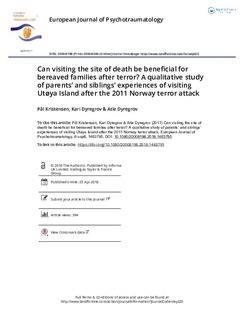| dc.contributor.author | Kristensen, Pål | |
| dc.contributor.author | Dyregrov, Kari | |
| dc.contributor.author | Dyregrov, Atle | |
| dc.coverage.spatial | Norway, Utøya | nb_NO |
| dc.date.accessioned | 2019-01-22T13:58:39Z | |
| dc.date.available | 2019-01-22T13:58:39Z | |
| dc.date.created | 2018-05-06T19:44:18Z | |
| dc.date.issued | 2018 | |
| dc.identifier.citation | Kristensen, P., Dyregrov, K., & Dyregrov, A. (2018). Can visiting the site of death be beneficial for bereaved families after terror? A qualitative study of parents’ and siblings’ experiences of visiting Utøya Island after the 2011 Norway terror attack. European Journal of Psychotraumatology, 8(sup6), 1-8. | nb_NO |
| dc.identifier.issn | 2000-8066 | |
| dc.identifier.uri | http://hdl.handle.net/11250/2581815 | |
| dc.description.abstract | Background. After the 2011 terror attack on Utøya Island, a collective visit was organized for bereaved families. There is limited knowledge whether bereaved families can benefit from such visits after terror.
Objective. This study aims to explore how bereaved families experienced visiting the site of death after the 2011 terror attack.
Method. As part of in-depth interviews, 22 parents and 16 siblings were asked whether they had visited Utøya and, if so, how they experienced the visit. Participants’ responses were analysed using thematic analysis.
Results. The results showed that for the majority of the bereaved, visiting Utøya had been important in processing their loss. Three key themes emerged as to what they considered important with the visit: ‘seeing the actual place of death’, ‘seeking factual information’, and ‘learning to know the island’. These factors were associated both with beneficial reactions (e.g. accepting the reality of the loss increased cognitive clarity) and with distressing reactions (e.g. intrusive thoughts, re-enactment images), but the benefits had outweighed the distress. Having the opportunity for multiple visits seemed to optimize the benefits.
Conclusion. Bereaved families should be offered the opportunity to visit the site of death after terror. | nb_NO |
| dc.language.iso | eng | nb_NO |
| dc.publisher | Taylor & Francis | nb_NO |
| dc.rights | Navngivelse 4.0 Internasjonal | * |
| dc.rights.uri | http://creativecommons.org/licenses/by/4.0/deed.no | * |
| dc.subject | terror | nb_NO |
| dc.subject | bereavement | nb_NO |
| dc.subject | family | nb_NO |
| dc.subject | grief | nb_NO |
| dc.subject | visiting death site | nb_NO |
| dc.title | Can visiting the site of death be beneficial for bereaved families after terror? A qualitative study of parents’ and siblings’ experiences of visiting Utøya Island after the 2011 Norway terror attack | nb_NO |
| dc.type | Journal article | nb_NO |
| dc.type | Peer reviewed | nb_NO |
| dc.description.version | publishedVersion | nb_NO |
| dc.rights.holder | © 2018 The Author(s). | nb_NO |
| dc.subject.nsi | VDP::Samfunnsvitenskap: 200::Psykologi: 260::Klinisk psykologi: 262 | nb_NO |
| dc.source.pagenumber | 8 | nb_NO |
| dc.source.volume | 8 | nb_NO |
| dc.source.journal | European Journal of Psychotraumatology | nb_NO |
| dc.identifier.doi | 10.1080/20008198.2018.1463795 | |
| dc.identifier.cristin | 1583709 | |
| cristin.unitcode | 203,3,60,0 | |
| cristin.unitname | Institutt for sosialfag og vernepleie - Bergen | |
| cristin.ispublished | true | |
| cristin.fulltext | original | |
| cristin.qualitycode | 1 | |

